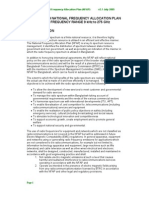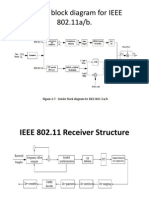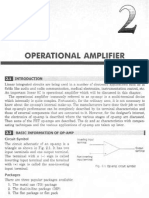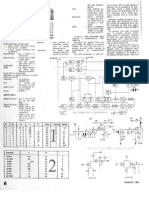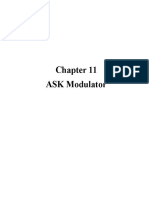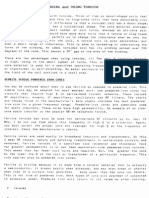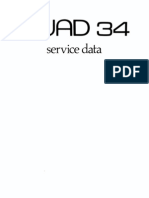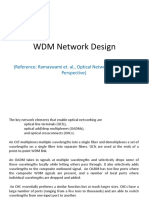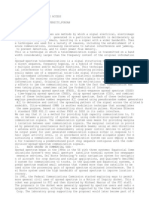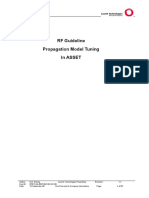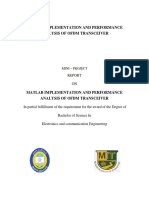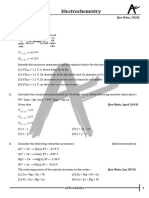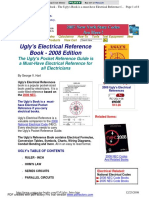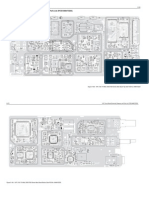Transmission Impairments and Channel Capacity
Transmission Impairments and Channel Capacity
Uploaded by
Sukhmeet KaurCopyright:
Available Formats
Transmission Impairments and Channel Capacity
Transmission Impairments and Channel Capacity
Uploaded by
Sukhmeet KaurOriginal Title
Copyright
Available Formats
Share this document
Did you find this document useful?
Is this content inappropriate?
Copyright:
Available Formats
Transmission Impairments and Channel Capacity
Transmission Impairments and Channel Capacity
Uploaded by
Sukhmeet KaurCopyright:
Available Formats
Transmission Impairments and Channel Capacity
1 Introduction
When a signal is transmitted over a communication channel, it is subjected to different types of impairments because of imperfect characteristics of the channel. As a consequence, the received and the transmitted signals are not the same. Outcome of the impairments are manifested in two different ways in analog and digital signals. These impairments introduce random modifications in analog signals leading to distortion. On the other hand, in case of digital signals, the impairments lead to error in the bit values. The impairment can be broadly categorised into the following three types: Attenuation and attenuation distortion Delay distortion Noise In this lesson these impairments are discussed in detail and possible approaches to overcome these impairments. The concept of channel capacity for both noise-free and noisy channels have also been introduced.
2 Attenuation
Irrespective of whether a medium is guided or unguided, the strength of a signal falls off with distance. This is known as attenuation. In case of guided media, the attenuation is logarithmic, whereas in case of unguided media it is a more complex function of the distance and the material that constitutes the medium. An important concept in the field of data communications is the use of on unit known as decibel (dB). To define it let us consider the circuit elements shown in Fig. 1. The elements can be either a transmission line, an amplifier, an attenuator, a filter, etc. In the figure, a transmission line (between points P1 and P2) is followed by an amplifier (between P2 and P3). The input signal delivers a power P1 at the input of an communication element and the output power is P2. Then the power gain G for this element in decibles is given by G = 10log2 P2/ P1. Here P2/ P1 is referred to as absolute power gain. When P2 > P1, the gain is positive, whereas if P2 < P1, then the power gain is negative and there is a power loss in the circuit element. For P 2 = 5mW, P1 = 10mW, the power gain G = 10log 5/10 = 10 -3 = -3dB is negative and it represents attenuation as a signal passes through the communication element. Example: Let us consider a transmission line between points 1 and 2 and let the energy strength at point 2 is 1/10 of that of point 1. Then attenuation in
dB is 10log10(1/10) = -10 dB. On the other hand, there is an amplifier between points 2 and 3. Let the power is 100 times at point 3 with respect to point 2. Then power gain in dB is 10log10(100/1) = 20 dB, which has a positive sign.
Figure 1 Compensation of attenuation using an amplifier The attenuation leads to several problems: Attenuation Distortion: If the strength of the signal is very low, the signal cannot be detected and interpreted properly at the receiving end. The signal strength should be sufficiently high so that the signal can be correctly detected by a receiver in presence of noise in the channel. As shown in Fig. 1, an amplifier can be used to compensate the attenuation of the transmission line. So, attenuation decides how far a signal can be sent without amplification through a particular medium. Attenuation of all frequency components is not same. Some frequencies are passed without attenuation, some are weakened and some are blocked. This dependence of attenuation of a channel on the frequency of a signal leads to a new kind of distortion attenuation distortion. As shown in Fig. 2, a square wave is sent through a medium and the output is no longer a square wave because of more attenuation of the high-frequency components in the medium.
Figure 2 Attenuation distortion of a square wave after passing through a medium. The effect of attenuation distortion can be reduced with the help of a suitable equalizer circuit, which is placed between the channel and the receiver. The
equalizer has opposite attenuation/amplification characteristics of the medium and compensates higher losses of some frequency components in the medium by higher amplification in the equalizer. Attenuation characteristics of three popular transmission media are shown in Fig. 3. As shown in the figure, the attenuation of a signal increases exponentially as frequency is increased from KHz range to MHz range. In case of coaxial cable attenuation increases linearly with frequency in the Mhz range. The optical fibre, on the other hand, has attenuation characteristic similar to a band-pass filter and a small frequency band in the THz range can be used for the transmission of signal.
Figure 3 Attenuation characteristics of the popular guided media
3 Delay distortion
The velocity of propagation of different frequency components of a signal are different in guided media. This leads to delay distortion in the signal. For a bandlimited signal, the velocity of propagation has been found to be maximum near the center frequency and lower on both sides of the edges of the frequency band. In case of analog signals, the received signal is distorted because of variable delay of different components. In case of digital signals, the problem is much more severe. Some frequency components of one bit position spill over to other bit positions, because of delay distortion. This leads to intersymbol interference, which restricts the maximum bit rate of
transmission through a particular transmission medium. The delay distortion can also be neutralised, like attenuation distortion, by using suitable equalizers.
4 Noise
As signal is transmitted through a channel, undesired signal in the form of noise gets mixed up with the signal, along with the distortion introduced by the transmission media. Noise can be categorised into the following four types: Thermal Noise Intermodulation Noise Cross talk Impulse Noise
The thermal noise is due to thermal agitation of electrons in a conductor. It is distributed across the entire spectrum and that is why it is also known as white noise (as the frequency encompass over a broad range of frequencies). When more than one signal share a single transmission medium, intermodulation noise is generated. For example, two signals f1 and f2 will generate signals of frequencies (f1 + f2) and (f1 - f2), which may interfere with the signals of the same frequencies sent by the transmitter. Intermodulation noise is introduced due to nonlinearity present in any part of the communication system. Cross talk is a result of bunching several conductors together in a single cable. Signal carrying wires generate electromagnetic radiation, which is induced on other conductors because of close proximity of the conductors. While using telephone, it is a common experience to hear conversation of other people in the background. This is known as cross talk. Impulse noise is irregular pulses or noise spikes of short duration generated by phenomena like lightning, spark due to loose contact in electric circuits, etc. Impulse noise is a primary source of bit-errors in digital data communication. This kind of noise introduces burst errors.
5 Bandwidth and Channel Capacity
Bandwidth refers to the range of frequencies that a medium can pass without a loss of one-half of the power (-3dB) contained in the signal. Figure 4 shows the bandwidth of a channel. The points Fl and Fh points correspond to 3bB of the maximum amplitude A.
Figure 4 Bandwidth of a channel Bandwidth of a medium decides the quality of the signal at the other end. A digital signal (usually aperiodic) requires a bandwidth from 0 to infinity. So, it needs a low-pass channel characteristic as shown in Fig. 5. On the other hand, a band-pass channel characteristic is required for the transmission of analog signals, as shown in Fig. 6.
Figure 5 Low-pass channel characteristic required for the transmission of digital signals
Figure 6 Bandpass channel characteristic required for the transmission of analog signals
Nyquist Bit Rate
The maximum rate at which data can be correctly communicated over a channel in presence of noise and distortion is known as its channel capacity. Consider first a noise-free channel of Bandwidth B. Based on Nyquist formulation it is known that given a bandwidth B of a channel, the maximum data rate that can be carried is 2B. This limitation arises due to the effect of intersymbol interference caused by the frequency components higher than B. If the signal consists of m discrete levels, then Nyquist theorem states: Maximum data rate where C = 2 B log2 m bits/sec,
C is known as the channel capacity, B is the bandwidth of the channel and m is the number of signal levels used.
Baud Rate: The baud rate or signaling rate is defined as the number of distinct symbols transmitted per second, irrespective of the form of encoding. For baseband digital transmission m = 2. So, the maximum baud rate = 1/Element width (in Seconds) = 2B Bit Rate: The bit rate or information rate I is the actual equivalent number of bits transmitted per second. I = Baud Rate Bits per Baud = Baud Rate N = Baud Rate log2m For binary encoding, the bit rate and the baud rate are the same; i.e., I = Baud Rate. Example: Let us consider the telephone channel having bandwidth B = 4 kHz. Assuming there is no noise, determine channel capacity for the following encoding levels: (i) 2, and (ii) 128. Ans: (i) C = 2B = 24000 = 8 Kbits/s (ii) C = 24000log2128 = 80007 = 56 Kbits/s
Effects of Noise
When there is noise present in the medium, the limitations of both bandwidth and noise must be considered. A noise spike may cause a given level to be interpreted as a signal of greater level, if it is in positive phase or a smaller level, if it is negative phase. Noise becomes more problematic as the number of levels increases.
Shannon Capacity (Noisy Channel)
In presence of Gaussian band-limited white noise, Shannon-Hartley theorem gives the maximum data rate capacity
C = B log2 (1 + S/N), where S and N are the signal and noise power, respectively, at the output of the channel. This theorem gives an upper bound of the data rate which can be reliably transmitted over a thermal-noise limited channel. Example: Suppose we have a channel of 3000 Hz bandwidth, we need an S/N ratio (i.e. signal to noise ration, SNR) of 30 dB to have an acceptable bit-error rate. Then, the maximum data rate that we can transmit is 30,000 bps. In practice, because of the presence of different types of noises, attenuation and delay distortions, actual (practical) upper limit will be much lower. In case of extremely noisy channel, C = 0 Between the Nyquist Bit Rate and the Shannon limit, the result providing the smallest channel capacity is the one that establishes the limit. Example: A channel has B = 4 KHz. Determine the channel capacity for each of the following signal-to-noise ratios: (a) 20 dB, (b) 30 dB, (c) 40 dB. Answer: (a) C= B log2 (1 + S/N) = 4103log2 (1+100) = 41033.322.004 = 26.6 kbits/s b) C= B log2 (1 + S/N) = 4103log2 (1+1000) = 41033.323.0 = 39.8 kbits/s (c) C= B log2 (1 + S/N) = 4103log2 (1+10000) = 41033.324.0 = 53.1 kbits/s Example: A channel has B = 4 KHz and a signal-to-noise ratio of 30 dB. Determine maximum information rate for 4-level encoding. Answer: For B = 4 KHz and 4-level encoding the Nyquist Bit Rate is 16 Kbps. Again for B = 4 KHz and S/N of 30 dB the Shannon capacity is 39.8 Kbps. The smallest of the two values has to be taken as the Information capacity I = 16 Kbps. Example: A channel has B = 4 kHz and a signal-to-noise ratio of 30 dB. Determine maximum information rate for 128-level encoding. Answer: The Nyquist Bit Rate for B = 4 kHz and M = 128 levels is 56 kbits/s. Again the Shannon capacity for B = 4 kHz and S/N of 30 dB is 39.8 Kbps. The smallest of the two values decides the channel capacity C = 39.8 kbps. Example: The digital signal is to be designed to permit 160 kbps for a bandwidth of 20 KHz. Determine (a) number of levels and (b) S/N ratio.
(a) Apply Nyquist Bit Rate to determine number of levels. C = 2B log2 (M), or 160103 = 220103 log2 (M), or M = 24, which means 4bits/baud. (b) Apply Shannon capacity to determine the S/N ratio C = B log2 (1+S/N), or 160103 = 20103 log2 (1+S/N) 103 log2 (M) , or S/N = 28 - 1, or S/N = 255, or S/N = 24.07 dB.
You might also like
- Explain How The Photon Concept and The FactDocument13 pagesExplain How The Photon Concept and The FactSophie Anne Trinidad Battung100% (1)
- National Frequency Allocation Plan v3.1Document172 pagesNational Frequency Allocation Plan v3.1MH Kawsar RudroNo ratings yet
- NUMERICAL - Electricity & Its Effects For (Class X)Document6 pagesNUMERICAL - Electricity & Its Effects For (Class X)Gayathiri Suresh80% (10)
- Fading ChannelsDocument15 pagesFading ChannelsAllumuru AnirudhNo ratings yet
- LIC Unit I FullDocument66 pagesLIC Unit I FullankurwidguitarNo ratings yet
- Calrec SeriesDocument13 pagesCalrec SeriescarlossanzguNo ratings yet
- A Turbo Code TutorialDocument9 pagesA Turbo Code Tutorialmehdimajidi797144No ratings yet
- FEKO. Script ExamplesDocument182 pagesFEKO. Script ExamplesLaz GsodfjxNo ratings yet
- BER of OFDM System Using Concatenated Forward Error Correcting Codes (FEC) Over Nakagami-M Fading ChannelDocument5 pagesBER of OFDM System Using Concatenated Forward Error Correcting Codes (FEC) Over Nakagami-M Fading Channelseventhsensegroup100% (1)
- LAB Physics Labexp7 Diffraction Grating Experiment With ReadingsDocument6 pagesLAB Physics Labexp7 Diffraction Grating Experiment With ReadingsVipul KumarNo ratings yet
- Building Distributed System To Handle Data in Internet of ThingsDocument86 pagesBuilding Distributed System To Handle Data in Internet of ThingsAli AliNo ratings yet
- Oren HARTAL - Electromagnetic Compatibility by DesignDocument462 pagesOren HARTAL - Electromagnetic Compatibility by Designoyavuz38No ratings yet
- Solution Manual Antenna Theory by Balanis Edition2 Chapter8b PDFDocument17 pagesSolution Manual Antenna Theory by Balanis Edition2 Chapter8b PDFsniyaNo ratings yet
- Design of Pyramidal Horn Antenna For UWB ApplicationsDocument3 pagesDesign of Pyramidal Horn Antenna For UWB ApplicationsAmador Garcia IIINo ratings yet
- Captured Power It Is The Power Available at The AntennaDocument2 pagesCaptured Power It Is The Power Available at The AntennaADSRNo ratings yet
- Transceiver Tr4 SSB CW - Yo7aotDocument10 pagesTransceiver Tr4 SSB CW - Yo7aotverd leonardNo ratings yet
- Nad 310 Integrated Amplifier SchematicDocument2 pagesNad 310 Integrated Amplifier SchematicRosevereNo ratings yet
- Design of LNA in S-Band - 1Document39 pagesDesign of LNA in S-Band - 1Sreedhar RallabhandiNo ratings yet
- Modul ASK Mod - DemodDocument45 pagesModul ASK Mod - DemodfarrasNo ratings yet
- Introduction To Troposcatter CommunicatiDocument12 pagesIntroduction To Troposcatter CommunicatiAnkit PahadiNo ratings yet
- Report of Comm. Sys. Project ASK, FSK & QAMDocument8 pagesReport of Comm. Sys. Project ASK, FSK & QAMMehryn JavedNo ratings yet
- Analog Communication Unit7 VtuDocument40 pagesAnalog Communication Unit7 Vturaghudathesh100% (2)
- Cmos OpampDocument3 pagesCmos OpampTànVìĐọcNo ratings yet
- Synchronous Detector: Apparatus RequiredDocument3 pagesSynchronous Detector: Apparatus RequiredvinothNo ratings yet
- Lecture1-3 18360 Ch2-StallingsDocument27 pagesLecture1-3 18360 Ch2-StallingsSuraj ShahNo ratings yet
- Peavey Electronics IncDocument3 pagesPeavey Electronics IncTrevor Washburn0% (1)
- Winding and Using ToroidsDocument6 pagesWinding and Using ToroidsSararu OvidiuNo ratings yet
- A High Gain, Fully Differential Single Stage Folded Cascade Op-Amp With 1GHZ BandwidthDocument5 pagesA High Gain, Fully Differential Single Stage Folded Cascade Op-Amp With 1GHZ BandwidthJournal of Telecommunications0% (1)
- Wireless Communications Wiley IEEE 2nd Edition Andreas F. Molisch download pdfDocument55 pagesWireless Communications Wiley IEEE 2nd Edition Andreas F. Molisch download pdfnoyanbohadi100% (1)
- Active Filters: Low Pass High Pass Band PassDocument40 pagesActive Filters: Low Pass High Pass Band PasskruthikahNo ratings yet
- Differential Pulse Code ModulationDocument2 pagesDifferential Pulse Code ModulationKuldeep Astik100% (1)
- Quad 34 Service Data ManualDocument37 pagesQuad 34 Service Data ManualciohaniNo ratings yet
- China TD21P8 M61266, M37160, Tea1506p, La9302Document1 pageChina TD21P8 M61266, M37160, Tea1506p, La9302Luis Liammas PerezNo ratings yet
- Beamwidth DefinitionDocument2 pagesBeamwidth DefinitionkiranamjadNo ratings yet
- Multiple Access TechniquesDocument35 pagesMultiple Access TechniquesPranav JadhavNo ratings yet
- WDM Network Design: (Reference: Ramaswami Et. Al., Optical Networks-A Practical Perspective)Document18 pagesWDM Network Design: (Reference: Ramaswami Et. Al., Optical Networks-A Practical Perspective)Pritam RoyNo ratings yet
- Electronic Projects: 18W Audio AmplifierDocument2 pagesElectronic Projects: 18W Audio AmplifierLaurentiu DraganNo ratings yet
- Gunn DiodeDocument11 pagesGunn DiodeGautam ChaurasiaNo ratings yet
- Chapter 7 Multiple Access TechniquesDocument65 pagesChapter 7 Multiple Access TechniquesRamyAgiebNo ratings yet
- Spread Spectrum Multiple AccessDocument6 pagesSpread Spectrum Multiple AccessgauravsanadhyaNo ratings yet
- AG312 Pin Diode PDFDocument18 pagesAG312 Pin Diode PDFtuwinnerNo ratings yet
- RF Guideline Propagation Model TuningDocument57 pagesRF Guideline Propagation Model Tuningaqua_salmanNo ratings yet
- EE 370, Lecture 07Document5 pagesEE 370, Lecture 07Peshal NayakNo ratings yet
- Channel EstimationDocument7 pagesChannel EstimationThejaswini NNo ratings yet
- Matlab Implementation and Performance Analysis of Ofdm TransceiverDocument19 pagesMatlab Implementation and Performance Analysis of Ofdm TransceiveraytenewNo ratings yet
- Unit - IV - Spread Spectrum ModulationDocument16 pagesUnit - IV - Spread Spectrum ModulationPrisha SinghNo ratings yet
- Tellegen's Theorem: Basic Electrical Engineering ProjectDocument13 pagesTellegen's Theorem: Basic Electrical Engineering Projectbrock lesnarNo ratings yet
- Microwave 10Document40 pagesMicrowave 10Kubilay ÖzdemirNo ratings yet
- Ppt-Open Area Test SiteDocument15 pagesPpt-Open Area Test SiteRoji Varghese Rajan100% (1)
- P-I-N Diode HandbookDocument137 pagesP-I-N Diode HandbookChangjian LiNo ratings yet
- 03 DatatransmissionDocument36 pages03 Datatransmission22520101No ratings yet
- Week 4 Physical LayerDocument61 pagesWeek 4 Physical LayerZA IzatNo ratings yet
- CH 03Document29 pagesCH 03Mohsin IqbalNo ratings yet
- Idresss Sir#2 OkDocument9 pagesIdresss Sir#2 OkDil NawazNo ratings yet
- Wireless and Mobile Technology-ADocument18 pagesWireless and Mobile Technology-Amanish tiwariNo ratings yet
- Computer Network Notes CS 602 LN 2Document8 pagesComputer Network Notes CS 602 LN 2sujoy.bhowmickNo ratings yet
- Physical Layer in Network: University of Technology Computer Science DepartmentDocument12 pagesPhysical Layer in Network: University of Technology Computer Science Departmentزينب جواد اسد كاظمNo ratings yet
- Data Communication and Computer Networks: Transmission ImpairmentDocument30 pagesData Communication and Computer Networks: Transmission Impairmentwarke abayNo ratings yet
- Knowledge Area 2Document99 pagesKnowledge Area 2panassabdulajmiiyyNo ratings yet
- PhysicalLayer 3Document40 pagesPhysicalLayer 3Pianto ArtNo ratings yet
- T3-Physical LayerDocument95 pagesT3-Physical Layerutkarsh.shrivastav202002No ratings yet
- Ch02 Telecommunications BasicsDocument10 pagesCh02 Telecommunications BasicsChristop22No ratings yet
- Basic Electronics - Types of InductorsDocument4 pagesBasic Electronics - Types of InductorsMansour MashaeiNo ratings yet
- 17 Equations That Changed The World - Business InsiderDocument7 pages17 Equations That Changed The World - Business InsiderAsmaniAlamNo ratings yet
- Sheet EEx73Document3 pagesSheet EEx73mohamedsabah22No ratings yet
- PS21245 eDocument9 pagesPS21245 eTol SirtNo ratings yet
- Switching Regulator Applications: Absolute Maximum RatingsDocument6 pagesSwitching Regulator Applications: Absolute Maximum RatingsadbeelNo ratings yet
- Aftermarket Parts List: Insist On Genuine PartsDocument12 pagesAftermarket Parts List: Insist On Genuine PartsshinichieNo ratings yet
- Electrochemistry Jee Main Selected 2Document4 pagesElectrochemistry Jee Main Selected 2createhistory2025No ratings yet
- 400w Mono Half Cut Cell Solar PanelDocument2 pages400w Mono Half Cut Cell Solar Panelssrkm guptaNo ratings yet
- NNH4-65C-R6-V2: Electrical SpecificationsDocument4 pagesNNH4-65C-R6-V2: Electrical SpecificationsDavid Angulo EsguerraNo ratings yet
- Final PhysicsREVISEDDocument6 pagesFinal PhysicsREVISEDalecksander2005No ratings yet
- Sessional 1 Solution EE4035 PSPA202203Document6 pagesSessional 1 Solution EE4035 PSPA202203awais.ali.khan610No ratings yet
- Circuit Design ProjectDocument20 pagesCircuit Design Projectlihisej594No ratings yet
- Sequencer For Dedusting Plants - Dc32Document12 pagesSequencer For Dedusting Plants - Dc32Gennius Flores100% (1)
- Salawudeen WorkDocument4 pagesSalawudeen Workmichealfajobi7No ratings yet
- BoouglyDocument8 pagesBoouglyKerryNo ratings yet
- SeaBattery SpecSheetDocument2 pagesSeaBattery SpecSheetjvrbuzonNo ratings yet
- Preview of Electronic Concepts An IntroductionDocument20 pagesPreview of Electronic Concepts An IntroductionJhonatan Gerardo Soto PuellesNo ratings yet
- ESD122 2-Channel ESD Protection Diode For USB Type-C and HDMI 2.0Document27 pagesESD122 2-Channel ESD Protection Diode For USB Type-C and HDMI 2.0H tavangarNo ratings yet
- INEX 48V Inverter Operating ManualDocument54 pagesINEX 48V Inverter Operating ManualJoseric21No ratings yet
- Fermi Surface: Notes By: Shahzaib ShahidDocument7 pagesFermi Surface: Notes By: Shahzaib ShahidShazaib MirzaNo ratings yet
- Camesa TechBulletin-023Document2 pagesCamesa TechBulletin-023Dmz FreakzNo ratings yet
- Controlador Temperatura TC3YTDocument6 pagesControlador Temperatura TC3YTLuiz Mauro XavierNo ratings yet
- Probo Step VXDocument3 pagesProbo Step VXkayproNo ratings yet
- Unit 2: Modeling in The Frequency Domain Part 5: Modeling Translational Mechanical SystemsDocument14 pagesUnit 2: Modeling in The Frequency Domain Part 5: Modeling Translational Mechanical SystemsANo ratings yet
- Candle Light-Style Organic Light-Emitting Diodes PDFDocument8 pagesCandle Light-Style Organic Light-Emitting Diodes PDFChu-hsiang HsuNo ratings yet
- Service Manual Pro5150Document56 pagesService Manual Pro5150Miguel Martinez100% (1)
- BH1417 FM TransmitterDocument4 pagesBH1417 FM TransmitterManoel Candido Barros NetoNo ratings yet
- PHY101E Module 7 1 (Electrostatics)Document11 pagesPHY101E Module 7 1 (Electrostatics)Benedict SalazarNo ratings yet

